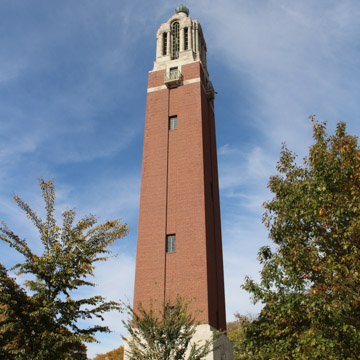South Dakota State University’s Coughlin Campanile has served as an icon for the school since its construction. When completed in 1929, the 165-foot tower was the tallest structure in the state, visible for more than twenty miles. Since its construction, it has served as an icon for the university.
The classically inspired tower was designed by Perkins and McWayne of Sioux Falls and built by Brookings firm Wold-Mark. Its architectural style blended with the nearby campus buildings. The 30-foot-tall base of the tower, constructed of Bedford stone, contains four entry portals highlighted by scroll-bracketed tables inscribed with the history of South Dakota and of the university. The steel-frame shaft is clad in red brick. The chimes tower is also constructed with Bedford stone and includes elongated Palladian windows with ornate pilasters and an ornamental motif at the top of the central arch on each of the four sides. Topping the tower is a beacon set in eight feet of copper, which contains leaded glass windows.
On the interior, 108 steps lead to a balcony level that is constructed of stone and wrought iron. Above this is the chimes chamber, where the original chimes were electronically controlled from a small room at the base of the tower (the carillon automatic player was eventually moved to a nearby campus building).
The campanile was a gift from alumnus Charles Coughlin, who graduated in 1909. After leaving SDSU, he became an executive with the Wisconsin-based Briggs and Stratton Company, founded by fellow SDSU alumnus Stephen F. Briggs (Class of 1907). Coughlin laid the cornerstone on June 10, 1929, during the first outdoor commencement exercises at the adjacent Coolidge Sylvan Theater.
In 2000, the Alumni Association led fundraising efforts for the structure’s restoration, which included mortar work and replacement of portions of the limestone base. Part of the funding came from Constance Goodwillie, whose father helped construct the tower.
References












